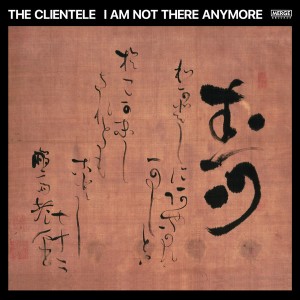
Over the 32-year career of the pop band The Clientele, critics and fans have often described their songs with words like “ethereal,” “shimmering,” “hazy,” “pretty” and “fragile.” Their singer, guitarist and lyricist Alasdair MacLean, though, has his own interpretation of the effect his music creates. “It’s that feeling of not being there,” he says. “What’s really been in all the Clientele records is a sense of not actually inhabiting the moment that your body is in.”
The band’s new album, I Am Not There Anymore, regularly evokes what MacLean calls “the feeling of not being real.” A lot of the lyrics were inspired by MacLean’s memories of the early summer in 1997, when his mother died. In songs like the elegiac yet buoyant “Lady Grey,” he writes about specific images that have stuck in his mind ever since, like the particular look of the light illuminating a country road. “Something that stays with you as an image becomes almost a symbol of something else,” MacLean says. “But you describe the image because you can’t describe the something else.”
The previous Clientele album, 2017’s Music for the Age of Miracles, arrived after a seven-year hiatus and featured the band’s familiar wistful melodies and haunting echo. Recording for I Am Not There Anymore began in 2019 and continued piecemeal until 2022—in part because of the pandemic, but also because the band wanted to experiment.
“We’d always been interested in music other than guitar music, like for donkey’s years,” MacLean says. This time out, he and bassist James Hornsey and drummer Mark Keen incorporated elements of post-bop jazz, contemporary classical and electronic music. According to MacLean, “None of those things had been able to find their way into our sound other than in the most passing way, in the faintest imprint.”
This stretching out—what MacLean calls “a leap forwards and to the side”—can be heard clearly in the song “Blue Over Blue,” with its percussive samples and its moments where the arrangement opens up suddenly into something cinematic in scope, with horns and strings.
“What happened with this record was that we bought a computer,” MacLean explains. Under the old Clientele way of recording, a tricky song like “Blue Over Blue” might’ve eaten up all their studio time, as they worked out the time signature and the instrumentation. For this album, though, the trio would lay down a few tracks and then take them home to play around, trying out different arrangements before returning to the studio to finish recording all the little instrumental enhancements.
The result is songs like “Claire’s Not Real,” which shifts fluidly from a light bossa nova beat to the Clientele’s classic chamber pop, and “Dying in May,” where Keen’s live drums weave around programmed drum and bass samples to create something polyrhythmic and avant-garde. MacLean says, “I’d been listening to On the Corner by Miles Davis, so I wanted to add in lots of bits and pieces on this album, like handclaps or vamping piano on the off beat.”
Keen is also responsible for the spare and lovely instrumental interstitials that appear throughout the LP—all called “Radials,” as in “the spokes from the center of the wheel.” They “change the focus in between songs,” according to MacLean. “Without those tracks, everything might be a bit too heavy. They make you look away for a little while so you can look back again later.” There’s a similar purpose to the cover image, taken from the 1823 Kameda Bōsai painting Long Life. It’s both a beautiful piece of abstract art and a poem about, in MacLean’s words, “the distance and surprise of getting older.”
Though the album functions as MacLean’s way of mourning, he notes that he’s not the kind of songwriter who ever sits down with a theme in mind. It’s more that “the music will bring images and then those images link of their own accord.” It’s a general mood he’s chasing with these loosely connected recollections, be it the particular look of a relative’s staircase in “Dying in May,” the scary adventure of being lost in the woods with his son in “Blue Over Blue,” or the eerie beauty of a sky lit orange by forest fires in “Claire’s Not Real.” (For more of MacLean’s impressionistic words, spend some time with his book Exhaust Fumes, Magnolias & Light: Selected Lyrics 1997-2021, published by Edge of the Lane Press.)
The eight-minute album-opener “Fables of the Silverlink” is another case in point. It has the complex orchestration of an epic, with multiple approaches to creating an inviting sonic space—from busy electronica to symphonic sweep. But the words are more down to earth, drifting from a memory of death to a description of staring out the windows at school in a null state, before ending with the lines “‘Till the street lamps broke the spell… I don’t know why.’”
“I thought this was a brave thing for a Clientele song to say,” MacLean explains. “Usually the pressure is to have some kind of neatness or conclusion. Finish the oil painting. Chip the last facet away from the jewel. And I thought, ‘I’m not going to do that here. I’m just going to say I don’t understand it.’”
Anyone looking for a thesis statement for this record should start there. As MacLean says, I Am Not There Anymore is all about “the memory of childhood but at the same time the impossibility of truly remembering childhood… or even knowing who or what you are.”